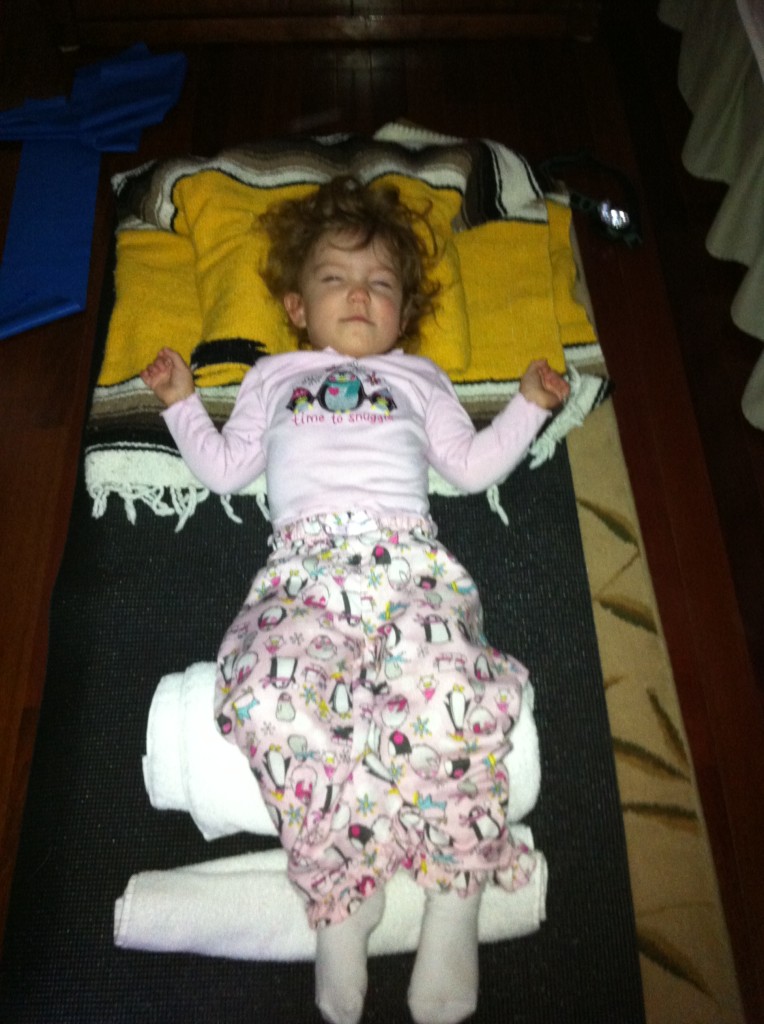Inspiring Calm…Teaching Yoga Relaxation to Our Kids
“Calm down!”
“Take a deep breath!”
“Relax!”
“Settle down!”
Words like these spill from our lips on a regular basis. Whether directed at our kids or other adults, they rarely have the desired effect. In fact, they often set into motion the opposite response. The person we direct them at gets more stressed or more worked up. Why is that?
I think the answer to that question can be found by looking in the mirror. When I ask myself what I’m feeling when I use those words, it’s no surprise they are so ineffective. When I say, “You need to calm down!” What I’m really communicating is, “I’m feeling freaked out by your emotions or actions right now, and I need them to go away so I can feel better myself.”
For example, if I’m trying to get AE in the bathtub, and she’s running around like a wild woman, I might say (and you can imagine the tone with which these words spill out) “You need to settle down! It’s time to get ready for bed by getting in the tub!”
But, what I’m really saying is, “I’m exhausted myself, but you are preventing me from getting to bed! So, stop doing what you’re doing and take care of me!”
You would immediately relax and comply if I said those words to you, right? Wrong! Kids (and other adults) generally don’t appreciate us placing the responsibility of dealing with our own emotions on them.
Imagine if instead of chasing her around and barking orders to settle down, I sat down by the tub and just practiced some deep breathing of my own (first calming my own emotional reactivity). What if I was then able to say, in my best massage therapist-like voice, “Would you like to get in this warm bath and relax?” Then I could put my hand in the water and say, “Ooo, this water feels so warm and soothing!”
We can inspire relaxation in our kids (and others) not by telling them it’s time to relax, but by being a relaxing authority in their presence. We can invite them to settle down by first settling down ourselves and then calmly inviting them to join us. Relaxation is a learned skill. And, we have to practice it ourselves before we can teach it to others.
After we’ve shown our kids how to shift into a lower gear off the mat, we can begin to let them experiment on the mat. The age of the child will greatly impact the amount of time he or she is able to practice Savasana, but here are some tips for getting started:
- – Allow them to catch you practicing Savasana. Many kids will want to try it just because they see you doing it.
- – Keep a basket of yoga props and mats on the floor so it’s accessible. Everyone enjoys Savasana more with props!
- – When you see them naturally slowing down, develop a relaxation “script.” When they are awake, but mellow try massaging their face, shoulders, back, arms and legs while saying “relax your face, shoulders, back etc.” Make audible sighs (big exhales) and encourage them to copy them.
- – Make the room as dark as they are comfortable with. Light stimulates the brain, darkness quiets it. It’s really hard for kids to relax in a bright room.
- – Keep your expectations realistic. They won’t always be in the mood to relax, and you can’t make the choice to relax for them. Success may be 2-5 minutes of relaxation.
How do you calm your own emotional reactivity so you can be a calming authority to your kids and others? What practical tips do you have for teaching relaxation to your kids? I’d love to get your input!
P.S. This post is part of a series on how I share the practice of yoga with kids. You can find other posts in this series here.







Coming from someone who just chased 4 kids into the bath this evening… And it wasn’t pretty… But they were covered with sand and sunscreen and salt water and it had to happen… But yes, my technique could have changed. I could have invited them into the relaxing feeling of being clean after a fantastic day at the beach instead of feeling exhausted with this last task ahead of me.
Oh, Suzy – I’m so glad to know I’m not the only one who handles bath time with a sometimes less than ideal tone. It seems to me that before bed is the trickiest time of the day to calm my own emotionally reactivity. I think I’m just pretty spent by that point. Awareness and intention are required to keep me from turning into “yelling mommy.”